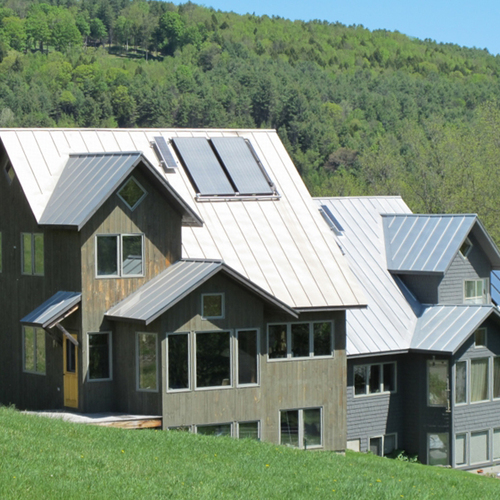
Image Credit: M.Maines
At the Unity, Maine, headquarters of the Maine Organic Farmers and Gardeners Association (MOFGA), engineer Jay LeGore has harnessed the power of the sun to replace about 200 gallons of propane a year.
Located far from fire hydrants, MOFGA’s exhibition hall was still required to have sprinklers to meet fire safety codes. The large, timber-framed structure, which sees 60,000 visitors each year during the Common Ground Country Fair and also houses the association’s offices, sits in the middle of a former potato field, with no fire hydrants nearby. Instead, 15,000 gallons of water are stored in pressurized tanks in a building adjacent to the exhibition hall.
To keep the tanks from freezing, the shed had been heated with a propane-fired furnace. To save fuel while serving as an experiment and example for demonstrations, Jay designed and built a wall-mounted solar air heater. Narrow vertical slots at each end of the collector allow air to flow from inside the shed, through a two-inch channel formed between the outside of the shed wall and black painted metal roofing panels that are horizontally installed. An inch and a half away from the metal panels are double-wall polycarbonate panels, commonly used for glazing greenhouses.
The metal panels get hot enough so that, on the 75°F day I was there, the air coming from the collector was noticeably warmer; a thermostat said 85°F. More important, after two long, cold winters without any other source of heat, the temperature in the shed never went below 40°F.
A squirrel cage blower forces air through the solar heater channels. I asked Jay why he hadn’t taken advantage of the stack effect and reduced electricity use by installing slots at the top and bottom of the panel instead of at the ends where a fan was required to move the air. He said that the stack effect would work great during the day, pulling in cooler air at floor level and releasing warmed air at the top of the panel, but that at night, the cycle would reverse and actually pull heat out of the building. Flaps could be used to stop that process, but in the interest of keeping things as low-tech, passive, and reliable as possible, the horizontal, fan-assisted arrangement was a better solution. He added that photovoltaic panels could have been used to power the fan, but the initial cost would have been prohibitive and the payback period too long; also, the shed was already tied to the grid.
The total cost for the system, which could be used for supplemental heating in workshops, barns, basements, commercial buildings, or other spaces where south-facing windows would not be preferable? About $1,000 for the panel components, and another $1,000 for the squirrel cage blower and control equipment. The payback period is about three years.
Weekly Newsletter
Get building science and energy efficiency advice, plus special offers, in your inbox.







0 Comments
Log in or create an account to post a comment.
Sign up Log in